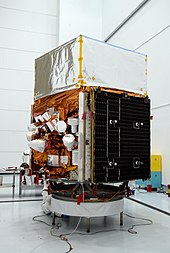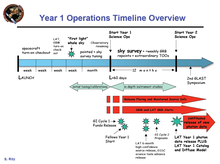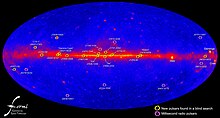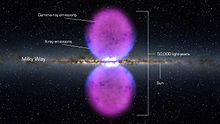Fermi Gamma-ray Space Telescope
 | |||||||
| Names | Gamma-ray Large Area Space Telescope | ||||||
|---|---|---|---|---|---|---|---|
| Mission type | Gamma-ray observatory | ||||||
| Operator | NASA · U.S. Department of Energy | ||||||
| COSPAR ID | 2008-029A | ||||||
| SATCAT no. | 33053 | ||||||
| Website | http://fermi.gsfc.nasa.gov/ | ||||||
| Mission duration | Planned: 5-10 years Elapsed: 16 years, 5 months and 16 days | ||||||
| Spacecraft properties | |||||||
| Manufacturer | General Dynamics[1] | ||||||
| Launch mass | 4,303 kg (9,487 lb)[1] | ||||||
| Dimensions | Stowed: 2.8 × 2.5 m (9.2 × 8.2 ft)[1] | ||||||
| Power | 1,500 W average[1] | ||||||
| Start of mission | |||||||
| Launch date | 11 June 2008, 16:05 UTC | ||||||
| Rocket | Delta II 7920-H #333 | ||||||
| Launch site | Cape Canaveral SLC-17B | ||||||
| Contractor | United Launch Alliance | ||||||
| Orbital parameters | |||||||
| Reference system | Geocentric | ||||||
| Regime | Low Earth | ||||||
| Semi-major axis | 6,912.9 km (4,295.5 mi) | ||||||
| Eccentricity | 0.001282 | ||||||
| Perigee altitude | 525.9 km (326.8 mi) | ||||||
| Apogee altitude | 543.6 km (337.8 mi) | ||||||
| Inclination | 25.58° | ||||||
| Period | 95.33 min | ||||||
| RAAN | 29.29° | ||||||
| Argument of perigee | 131.16° | ||||||
| Mean anomaly | 229.00° | ||||||
| Mean motion | 15.10 rev/day | ||||||
| Velocity | 7.59 km/s (4.72 mi/s) | ||||||
| Epoch | 23 February 2016, 04:46:22 UTC[2] | ||||||
| |||||||

| |||||||
The Fermi Gamma-ray Space Telescope (FGST[3]), formerly called the Gamma-ray Large Area Space Telescope (GLAST), is a space observatory being used to perform gamma-ray astronomy observations from low Earth orbit. Its main instrument is the Large Area Telescope (LAT), with which astronomers mostly intend to perform an all-sky survey studying astrophysical and cosmological phenomena such as active galactic nuclei, pulsars, other high-energy sources and dark matter. Another instrument aboard Fermi, the Gamma-ray Burst Monitor (GBM; formerly GLAST Burst Monitor), is being used to study gamma-ray bursts.[4]
Fermi was launched on 11 June 2008 at 16:05 UTC aboard a Delta II 7920-H rocket. The mission is a joint venture of NASA, the United States Department of Energy, and government agencies in France, Germany, Italy, Japan, and Sweden.[5]
Overview
Fermi includes two scientific instruments, the Large Area Telescope (LAT) and the Gamma-ray Burst Monitor (GBM).
- The LAT is an imaging gamma-ray detector (a pair-conversion instrument) which detects photons with energy from about 20 million to about 300 billion electron volts (20 MeV to 300 GeV),[6] with a field of view of about 20% of the sky; it may be thought of as a sequel to the EGRET instrument on the Compton gamma ray observatory.
- The GBM consists of 14 scintillation detectors (twelve sodium iodide crystals for the 8 keV to 1 MeV range and two bismuth germanate crystals with sensitivity from 150 keV to 30 MeV), and can detect gamma-ray bursts in that energy range across the whole of the sky not occluded by the Earth.
General Dynamics Advanced Information Systems (formerly Spectrum Astro and now Orbital Sciences) in Gilbert, Arizona designed and built the spacecraft that carries the instruments. It travels in a low, circular orbit with a period of about 95 minutes. Its normal mode of operation maintains its orientation so that the instruments will look away from the Earth, with a "rocking" motion to equalize the coverage of the sky. The view of the instruments will sweep out across most of the sky about 16 times per day. The spacecraft can also maintain an orientation that points to a chosen target.
Both science instruments underwent environmental testing, including vibration, vacuum, and high and low temperatures to ensure that they can withstand the stresses of launch and continue to operate in space. They were integrated with the spacecraft at the General Dynamics ASCENT facility in Gilbert, Arizona.
Data from the instruments are available to the public through the Fermi Science Support Center web site. Software for analyzing the data is also available.
 |
GLAST renamed Fermi Gamma-ray Space Telescope
Fermi gained its new name in 2008: On 26 August 2008, GLAST was renamed the "Fermi Gamma-ray Space Telescope" in honor of Enrico Fermi, a pioneer in high-energy physics.[7]
NASA's Alan Stern, associate administrator for Science at NASA Headquarters, launched a public competition 7 February 2008, closing 31 March 2008, to rename GLAST in a way that would "capture the excitement of GLAST's mission and call attention to gamma-ray and high-energy astronomy ... something memorable to commemorate this spectacular new astronomy mission ... a name that is catchy, easy to say and will help make the satellite and its mission a topic of dinner table and classroom discussion".[8][9]
Mission
NASA designed the mission with a five-year lifetime, with a goal of ten years of operations.[10]
The key scientific objectives of the Fermi mission have been described as:[11]
- To understand the mechanisms of particle acceleration in active galactic nuclei (AGN), pulsars, and supernova remnants (SNR).
- Resolve the gamma-ray sky: unidentified sources and diffuse emission.
- Determine the high-energy behavior of gamma-ray bursts and transients.
- Probe dark matter (e.g. by looking for an excess of gamma rays from the center of the Milky Way) and early Universe.
- Search for evaporating primordial micro black holes (MBH) from their presumed gamma burst signatures [Hawking Radiation component].
The National Academies of Sciences ranked this mission as a top priority.[12] Many new possibilities and discoveries are anticipated to emerge from this single mission and greatly expand our view of the Universe.[12][13] (The following list is abbreviated as discoveries are made. To read about discoveries already made, see "Discoveries" below.)
- Study energy spectra and variability of wavelengths of light coming from blazars so as to determine the composition of the black hole jets aimed directly at Earth -- whether they are
- Study gamma-ray bursts with an energy range several times more intense than ever before so that scientists may be able to understand them better.
- Study younger, more energetic pulsars in the Milky Way than ever before so as to broaden our understanding of stars. Study the pulsed emissions of magnetospheres so as to possibly solve how they are produced. Study how pulsars generate winds of interstellar particles.
- Provide new data to help improve upon existing theoretical models of our own galaxy.
- Study better than ever before whether ordinary galaxies are responsible for gamma-ray background radiation. The potential for a tremendous discovery awaits if ordinary sources are determined to be irresponsible, in which case the cause may be anything from self-annihilating dark matter to entirely new chain reactions among interstellar particles that have yet to be conceived.
- Study better than ever before how concentrations of visible and ultraviolet light change over time. The mission should easily detect regions of spacetime where gamma-rays interacted with visible or UV light to make matter. This can be seen as an example of E=mc2 working in reverse, where energy is converted into mass, in the early universe.
- Study better than ever before how our own Sun produces gamma rays in solar flares.
- Dark matter[21]
- Search for evidence that dark matter is made up of weakly interacting massive particles, complementing similar experiments already planned for the Large Hadron Collider as well as other underground detectors. The potential for a tremendous discovery in this area is possible over the next several years.
- Test better than ever before certain established theories of physics, such as whether the speed of light in vacuum remains constant regardless of wavelength. Einstein's general theory of relativity contends that it does, yet some models in quantum mechanics and quantum gravity predict that it may not. Search for gamma rays emanating from former black holes that once exploded, providing yet another potential step toward the unification of quantum mechanics and general relativity. Determine whether photons naturally split into smaller photons, as predicted by quantum mechanics and already achieved under controlled, man-made experimental conditions.
- Unknown discoveries[23]
- Scientists estimate a very high possibility for new scientific discoveries, even revolutionary discoveries, emerging from this single mission.
 |
 |
Mission timeline
Prelaunch
On 4 March 2008, the spacecraft arrived at the Astrotech payload processing facility in Titusville, Florida.[24] On 4 June 2008, after several previous delays, launch status was retargeted for 11 June at the earliest,[25][26] the last delays resulting from the need to replace the Flight Termination System batteries.[27] The launch window extended from 11:45 a.m. until 1:40 p.m. EDT (15:45-17:40 GMT) daily, until 7 August 2008.[27]
Launch


Launch occurred successfully on 11 June 2008 at 16:05, and the spacecraft separated from the carrier rocket about 75 minutes later. The spacecraft departed from pad B at Cape Canaveral Air Force Station Space Launch Complex 17 aboard a Delta 7920H-10C rocket.
Orbit
Fermi resides in a low-Earth circular orbit at an altitude of 550 km (340 mi), and at an inclination of 28.5 degrees.[28]
Software modifications
GLAST received some minor modifications to its computer software on 23 June 2008.
LAT/GBM computers operational
Computers operating both the LAT and GBM and most of the LAT's components were turned on 24 June 2008. The LAT high voltage was turned on 25 June, and it began detecting high-energy particles from space, but minor adjustments were still needed to calibrate the instrument. The GBM high voltage was also turned on 25 June, but the GBM still required one more week of testing/calibrations before searching for gamma-ray bursts.
Sky survey mode
After presenting an overview of the Fermi instrumentation and goals, Jennifer Carson of SLAC National Accelerator Laboratory had concluded that the primary goals were "all achievable with the all-sky scanning mode of observing".[29] Fermi switched to "sky survey mode" on 26 June 2008 so as to begin sweeping its field of view over the entire sky every three hours (every two orbits).
Collision avoided
On 30 April 2013, NASA revealed that the telescope had narrowly avoided a collision a year earlier with a defunct Cold War-era Soviet spy satellite, Kosmos 1805, in April 2012. Orbital predictions several days earlier indicated that the two satellites were expected to occupy the same point in space within 30 milliseconds of each other. On 3 April, telescope operators decided to stow the satellite's high-gain parabolic antenna, rotate the solar panels out of the way and to fire Fermi's rocket thrusters for one second to move it out of the way. Even though the thrusters had been idle since the telescope had been placed in orbit nearly five years earlier, they worked correctly and disaster was thus avoided.[30]
Extended mission 2013-2018
In August 2013 Fermi started its 5-year mission extension.[31]
Discoveries

Pulsar discovery
The first major discovery came when the space telescope detected a pulsar in the CTA 1 supernova remnant that appeared to emit radiation in the gamma ray bands only, a first for its kind.[32] This new pulsar sweeps the Earth every 316.86 milliseconds and is about 4,600 light years away.[33]
Greatest GRB energy release
In September 2008, the gamma-ray burst GRB 080916C in the constellation Carina was recorded by the Fermi telescope. This burst is notable as having “the largest apparent energy release yet measured”.[34] The explosion had the power of about 9,000 ordinary supernovae, and the relativistic jet of material ejected in the blast must have moved at a minimum of 99.9999% the speed of light. Overall, GRB 080916C had "the greatest total energy, the fastest motions, and the highest-energy initial emissions" ever seen.[35]
Cosmic rays and supernova remnants
In February 2010,[36] it was announced that Fermi-LAT had determined that supernova remnants act as enormous accelerators for cosmic particles. This determination fulfills one of the stated missions for this project.[37]
Background gamma ray sources
In March 2010 it was announced that active galactic nuclei are not responsible for most gamma-ray background radiation.[38] Though active galactic nuclei do produce some of the gamma-ray radiation detected here on Earth, less than 30% originates from these sources. The search now is to locate the sources for the remaining 70% or so of all gamma-rays detected. Possibilities include star forming galaxies, galactic mergers, and yet-to-be explained dark matter interactions.
Milky Way Gamma/X-ray bubbles
In November 2010, it was announced two gamma-ray and X-ray bubbles were detected around Earth's galaxy, the Milky Way.[39] The bubbles, named Fermi Bubbles, extend about 25 thousand light years distant above and below the center of the galaxy.[39] The galaxy's diffuse gamma-ray fog hampered prior observations, but the discovery team led by D. Finkbeiner, building on research by G. Dobler, worked around this problem.[39]
Highest energy light ever seen from the Sun
In early 2012, Fermi/GLAST observed the highest energy light ever seen in a solar eruption.[40]
At the flare's peak, the LAT detected gamma rays with two billion times the energy of visible light, or about four billion electron volts (GeV), easily setting a record for the highest-energy light ever detected during or immediately after a solar flare
— NASA[40]
Terrestrial gamma-ray flash observations
Fermi telescope has observed and detected numerous terrestrial gamma-ray flashes and discovered that such flashes can produce 100 trillion positrons, far more than scientists had previously expected.[41]
GRB 130427A

On 27 April 2013, Fermi detected GRB 130427A, a gamma-ray burst with one of the highest energy outputs yet recorded.[42] This included detection of a gamma-ray over 94 billion electron volts (GeV).[42] This broke Fermi's previous record detection, by over three times the amount.[42]
GRB coincident with gravitational wave event
On 14 September 2015, coincident with the first observation of gravitational waves by the LIGO collaboration, Fermi's Gamma-Ray Burst Monitor detected a weak gamma-ray burst above 50 keV, starting 0.4 seconds after the LIGO event and with a positional uncertainty region that overlapped that of the LIGO observation. Although it is not certain that the two observations are from the same event, nor that the GBM event is not noise, the Fermi team calculates the odds of that being a coincidence at only 0.22%.[43]
However, observations using the INTEGRAL telescope, through the all-sky SPI-ACS instrument, indicate that the amount of energy in gamma-ray and hard X-ray emission from the event was less than one part in a million of the energy emitted in the form of gravitational waves, concluding that "this limit excludes the possibility that the event is associated with substantial gamma-ray radiation, directed towards the observer."[44]
Black hole mergers of the type thought to have produced the gravitational wave event are not expected to produce gamma-ray bursts, as stellar-mass black hole binaries are not expected to have large amounts of orbiting matter. Abraham Loeb has theorised that if a massive star is rapidly rotating, the centrifugal force produced during its collapse will lead to the formation of a rotating bar that breaks into two dense clumps of matter with a dumbbell configuration that becomes a black hole binary, and at the end of the star's collapse it triggers a gamma-ray burst.[45][46] Loeb suggests that the 0.4 second delay is the time it took the gamma-ray burst to cross the star, relative to the gravitational waves.[45][47]
Fermi science packages
Gamma-ray Burst Monitor (GBM)
The Gamma-ray Burst Monitor (GBM) (formerly GLAST Burst Monitor) detects sudden flares of gamma-rays produced by gamma ray bursts and solar flares. Its scintillators are on the sides of the spacecraft to view all of the sky which is not blocked by the Earth. The design is optimized for good resolution in time and photon energy.
"Gamma-ray bursts are so bright we can see them from billions of light years away, which means they occurred billions of years ago, and we see them as they looked then," stated Charles Meegan of NASA's Marshall Space Flight Center.[48]
The Gamma-ray Burst Monitor has detected gamma rays from positrons generated in powerful thunderstorms.[41]
GBM participating institutions
US team institutions
German team institutions
Large Area Telescope (LAT)
The Large Area Telescope (LAT) detects individual gamma rays using technology similar to that used in terrestrial particle accelerators. Photons hit thin metal sheets, converting to electron-positron pairs, via a process known as pair production. These charged particles pass through interleaved layers of silicon microstrip detectors, causing ionization which produce detectable tiny pulses of electric charge. Researchers can combine information from several layers of this tracker to determine the path of the particles. After passing through the tracker, the particles enter the calorimeter, which consists of a stack of caesium iodide scintillator crystals to measure the total energy of the particles. The LAT's field of view is large, about 20% of the sky. The resolution of its images is modest by astronomical standards, a few arc minutes for the highest-energy photons and about 3 degrees at 100 MeV. The LAT is a bigger and better successor to the EGRET instrument on NASA's Compton Gamma Ray Observatory satellite in the 1990s. Several countries produced the components of the LAT, who then sent the components for assembly at SLAC National Accelerator Laboratory. SLAC also hosts the LAT Instrument Science Operations Center, which supports the operation of the LAT during the Fermi mission for the LAT scientific collaboration and for NASA.
LAT participating institutions
US team institutions
- Stanford University, Physics Department, Fermi group & Hansen Experimental Physics Laboratory
- SLAC National Accelerator Laboratory, Particle Astrophysics group and Kavli Institute for Particle Astrophysics and Cosmology
- NASA Goddard Space Flight Center, Astrophysics Science Division
- NASA Ames Research Center
- U.S. Naval Research Laboratory, High Energy Space Environment (HESE) branch
- Ohio State University, Physics Department
- University of California, Santa Cruz, Physics Department and Institute for Particle Physics
- Sonoma State University, Department of Physics & Astronomy
- University of Washington
- Purdue University Calumet
- University of Denver
Japanese team institutions
- University of Tokyo
- Tokyo Institute of Technology
- Japan Aerospace Exploration Agency
- Hiroshima University
- Ibaraki University
Austrian team institution
Icelandic team institutions
German team institutions
Italian team institutions
- Italian Space Agency Science Data Center
- INAF Istituto di Radioastronomia di Bologna
- INAF Istituto di Fisica Cosmica, Milano
- INFN and University of Bari
- INFN and University of Padova
- INFN and University of Perugia
- INFN and University of Pisa
- INFN and University of Rome Tor Vergata
- INFN and University of Trieste
- INFN and University of Udine
French team institutions
- Institut de Recherche en Astrophysique et Planétologie, Université Paul Sabatier, Toulouse
- Laboratoire AIM, CEA Saclay
- Laboratoire Leprince-Ringuet de l'École Polytechnique
- University of Bordeaux I
- Laboratoire Univers et Particules, Montpellier 2 University
Spanish team institution
- Institut de Ciències de l'Espai, Barcelona
Swedish team institutions
Education and public outreach
Education and public outreach are important components of the Fermi project. The main Fermi education and public outreach website at http://glast.sonoma.edu offers gateways to resources for students, educators, scientists, and the public. NASA's Education and Public Outreach (E/PO) group operates the Fermi education and outreach resources at Sonoma State University.
Rossi Prize
The 2011 Bruno Rossi Prize was awarded to Bill Atwood, Peter Michelson and the Fermi LAT team "for enabling, through the development of the Large Area Telescope, new insights into neutron stars, supernova remnants, cosmic rays, binary systems, active galactic nuclei and gamma-ray bursts."[49]
Discoveries
 |
References
- ^ a b c d "GLAST Science Writer's Guide" (PDF). NASA. February 2008. Retrieved 23 February 2016.
- ^ "Fermi - Orbit". Heavens Above. 23 February 2016. Retrieved 23 February 2016.
- ^ Stanford University: "FGST" is a now common acronym.
- ^ "NASA's GLAST Burst Monitor Team Hard at Work Fine-Tuning Instrument and Operations". NASA. 28 July 2008.
- ^ "An Astro-Particle Physics Partnership Exploring the High Energy Universe - List of funders". SLAC. Retrieved 9 August 2007.
- ^ Harrington, J. D.; Harris, David; Cominsky, Lynn (26 August 2008). "NASA Renames Observatory for Fermi, Reveals Entire Gamma-Ray Sky". NASA. Release no. 08-214. Retrieved 27 October 2014.
- ^ "First Light for the Fermi Space Telescope". NASA. 26 August 2008.
- ^ "NASA Calls for Suggestions to Re-Name Future Telescope Mission". NASA. 7 February 2008. Retrieved 10 February 2008.
- ^ "Name that Space Telescope!". NASA. 8 February 2008.
- ^ "The GLAST Mission: GLAST Overview, mission length". NASA. Retrieved 9 August 2007.
- ^ "The Mission". SLAC. Retrieved 9 August 2007.
- ^ a b "NASA - Q&A ON THE GLAST MISSION". Nasa: Fermi Gamma-ray Space Telescope. NASA. 28 August 2008. Retrieved 29 April 2009.
- ^ See also Nasa - Fermi Science and NASA - Scientists Predict Major Discoveries for GLAST.
- ^ NASA - Blazars and Active Galaxies. Nasa.gov (28 August 2008). Retrieved on 16 November 2010.
- ^ NASA - GLAST Gamma-ray Bursts. Nasa.gov (28 August 2008). Retrieved on 16 November 2010.
- ^ NASA - Neutron Stars. Nasa.gov. Retrieved on 16 November 2010.
- ^ NASA - Milky Way Galaxy. Nasa.gov (28 August 2008). Retrieved on 16 November 2010.
- ^ NASA - The Gamma-ray Background. Nasa.gov (28 August 2008). Retrieved on 16 November 2010.
- ^ NASA - The Early Universe. Nasa.gov (28 August 2008). Retrieved on 16 November 2010.
- ^ NASA - Solar System: Sun, Moon, and Earth. Nasa.gov. Retrieved on 2 September 2011.
- ^ NASA - Dark Matter. Nasa.gov (28 August 2008). Retrieved on 16 November 2010.
- ^ NASA - Testing Fundamental Physics. Nasa.gov (28 August 2008). Retrieved on 16 November 2010.
- ^ NASA - Scientists Predict Major Discoveries for GLAST. Nasa.gov (28 August 2008). Retrieved on 16 November 2010.
- ^ "GLAST Spacecraft Arrives in Florida to Prepare for Launch". NASA.
- ^ "Spaceflight Now – Tracking Station — Worldwide launch schedule". Retrieved 4 June 2008.
- ^ "GLAST Mission: Coverage Latest News". Retrieved 4 June 2008.
- ^ a b "NASA - Expendable Launch Vehicle Status Report". NASA. 6 June 2008. Retrieved 9 June 2008.
- ^ "The GLAST Mission: GLAST Overview, orbital information". NASA. Retrieved 9 August 2007.
- ^ Carson, Jennifer (2007). "GLAST: physics goals and instrument status". Journal of Physics: Conference Series. 60: 115–118. arXiv:astro-ph/0610960. Bibcode:2007JPhCS..60..115C. doi:10.1088/1742-6596/60/1/020.
- ^ The Day NASA's Fermi Dodged a 1.5-ton Bullet
- ^ Mission extension
- ^ Fermi Telescope Makes First Big Discovery: Gamma Ray Pulsar. Universe Today. Retrieved on 16 November 2010.
- ^ Cosmos Online - New kind of pulsar discovered
- ^ The Fermi LAT and Fermi GBM Collaborations (2009). "Fermi Observations of High-Energy Gamma-Ray Emission from GRB 080916C". Science. 323 (922): 1688–1693. Bibcode:2009Sci...323.1688A. doi:10.1126/science.1169101. PMID 19228997.
- ^ "Most Extreme Gamma-ray Blast Ever, Seen By Fermi Gamma-ray Telescope". Science Daily. 19 February 2009. Retrieved 13 January 2010.
- ^ NASA’s Fermi Closes on Source of Cosmic Rays, NASA
- ^ Cosmic Rays and Supernova Remnants, NASA
- ^ NASA’s Fermi Probes “Dragons” of the Gamma-ray Sky, NASA
- ^ a b c Astronomers find giant, previously unseen structure in our galaxy (November 9, 2010) - E! Science News
- ^ a b NASA's Fermi Detects the Highest-Energy Light From a Solar Flare 06.11.12
- ^ a b NASA's Fermi Catches Thunderstorms Hurling Antimatter into Space
- ^ a b c ASA's Fermi, Swift See 'Shockingly Bright' Burst 05.03.13
- ^ Connaughton, V.; Burns, E.; Goldstein, A.; Briggs, M. S.; Zhang, B.-B.; et al. (16 February 2016). "Fermi GBM Observations of LIGO Gravitational Wave event GW150914". arXiv:1602.03920v3 [astro-ph.HE].
- ^ Savchenko, V.; Ferrigno, C.; Mereghetti, S.; Natalucci, L.; Bazzano, A.; et al. (12 February 2016). "INTEGRAL upper limits on gamma-ray emission associated with the gravitational wave event GW150914". arXiv:1602.04180v1 [astro-ph.HE].
- ^ a b Loeb, Abraham (15 February 2016). "Electromagnetic Counterparts to Black Hole Mergers Detected by LIGO". arXiv:1602.04735v1 [astro-ph.HE].
- ^ Woo, Marcus (16 February 2016). "LIGO's black holes may have lived and died inside a huge star". New Scientist. Retrieved 17 February 2016.
- ^ Gough, Evan (18 February 2016). "Did a Gamma Ray Burst Accompany LIGO's Gravity Wave Detection?". Universe Today. Retrieved 19 February 2016.
- ^ "GLAST Off!". NASA.
- ^ "Astronomers Honored for Excellence by the American Astronomical Society".
External links
- Fermi website at NASA.gov
- Fermi website by NASA's Goddard Space Flight Center
- Fermi website at Sonoma.edu
- Large Area Telescope website at Stanford.edu
- Gamma-ray Burst Monitor website by NASA's Marshall Space Flight Center

